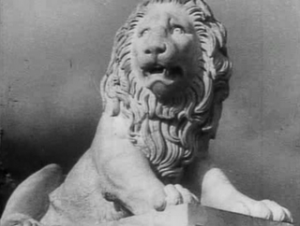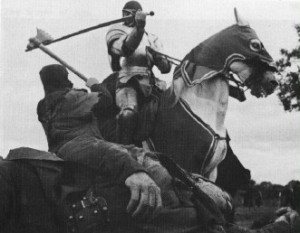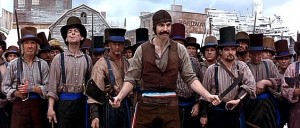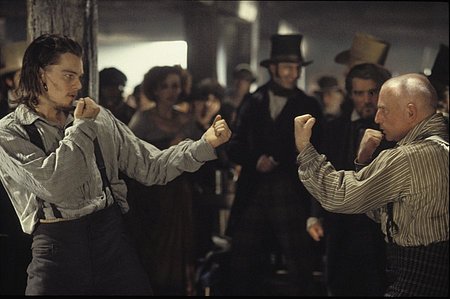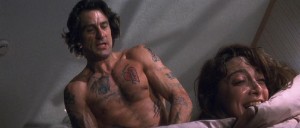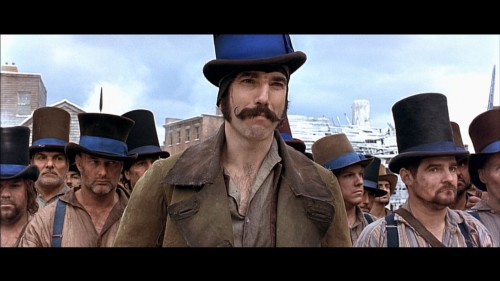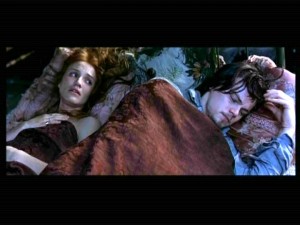From the Chicago Reader (December 20, 2002). — J.R.
Gangs of New York
*** (A must-see)
Directed by Martin Scorsese
Written by Jay Cocks, Steven Zaillian, and Kenneth Lonergan
With Leonardo DiCaprio, Daniel Day-Lewis, Cameron Diaz, Liam Neeson, Jim Broadbent, John C. Reilly, Henry Thomas, Brendan Gleeson, and David Hemmings.
For almost the first two-thirds of Martin Scorsese’s 168-minute Gangs of New York, I was entranced. I felt like I was watching a boys’ bloodthirsty adventure story — a blend of pirate saga, 19th-century revenge tale (three parts Dumas to one part Hugo), sword-and-sandal romp, and Viking epic poem, all laced with references to works ranging from Orson Welles’s claustrophobic Macbeth (the beginning of the prologue) to Pieter Brueghel’s spacious Slaughter of the Innocents (at the end of the prologue) and incorporating romantic touchstones from Potemkin (a stone lion), The Lusty Men (hidden possessions), Chimes at Midnight (thrusts and counterthrusts), and The Shanghai Gesture (prostitutes in hanging cages).
Scorsese once described his concept of the film as a western set on Mars, which adds two more playgrounds to the above list and helps explain the kind of historical fantasy he had in mind. I know little about New York’s early history, yet I was impressed by how thoroughly he wanted to steep me in its otherness. This is undoubtedly why the title “New York City 1846” doesn’t appear until the end of the prologue, after we’ve spent a good quarter of an hour watching massive crowds of Irish Catholics and American “nativists” hack one another to pieces on a huge foreign-looking turf identified as Manhattan’s Lower East Side, each group trying to eliminate the other.
The same overarching exoticism carried me through most of the film’s long middle section, which begins “16 years later.” The Irish Amsterdam Vallon (Leonardo DiCaprio) emerges from 16 years in the Hellgate House of Reform and ingratiates himself with nativist William “Bill the Butcher” Cutting (Daniel Day-Lewis). Years earlier Cutting killed Vallon’s father, a priest (Liam Neeson), and now he rules the neighborhood. The last section of the movie is set during the 1863 draft riots, and here the personal, oedipal revenge story and the wider historical epic finally come together in a fusion that seems straight out of D.W. Griffith — complete with black bashing. Yet the intended dramatic peak feels like a pit — one filled with corpses we haven’t been persuaded to mourn. And instead of adding up to something meaningful, the movie seems hollow and affectless — as if all the spectacular bloodletting has drained the story of its raison d’etre.
The film becomes downright offensive during the final credits, over which the U2 anthem “The Hands That Built America” plays. If these are the hands that built this country, as the song triumphantly claims, why don’t we ever see them building something instead of slashing, smashing, severing, gutting, burning, and mauling everyone and everything in sight? Is it possible that Scorsese, without meaning to — he does, after all, include some ironic disclaimers — is actually celebrating ethnic cleansing, as Griffith did in The Birth of a Nation? And is it churlish to ask why, after making so many allusions to nativists, Scorsese couldn’t allude even once to Native Americans to throw some ironic backlighting on the label? But who knows? Maybe some real Native Americans got lost in the final edit. After all, when you’re playing big-money games of this kind, the thoughtful footnotes often get lost.
To understand what went wrong, it might help to return to the boys’ adventure mode and ask why Scorsese’s film, for all its ambitions, never manages to get beyond it. In fairness to him, he has often tried to make grown-up movies. A short list of such efforts would include Alice Doesn’t Live Here Anymore (1975), The Last Temptation of Christ (1988), The Age of Innocence (1993), Kundun (1997), Bringing Out the Dead (1999), and his wonderful recent documentary My Voyage to Italy (2001). But the films he has been most handsomely rewarded for, critically as well as commercially, have tended to be the ones that put on display the callowness of violent adolescents of all ages, such as Mean Streets (1973), Taxi Driver (1976), Raging Bull (1980), GoodFellas (1990), and Cape Fear (1991).
Some of his more ambitious features — including New York, New York (1977), The King of Comedy (1982), The Color of Money (1986), and Casino (1995) — might even be said to be duels between adult and adolescent impulses. One reason The King of Comedy remains my favorite of all his pictures — though I initially found it flatter than a pancake — is the complex and ambiguous way it defines many of those impulses, offering, for instance, Jerry Lewis, who has embodied adolescence longer and more hysterically than any other American actor, as the adult figure. And one reason I’ve never much cared for The Color of Money is that it winds up equating adulthood with Paul Newman’s shameless pandering to the Academy in hopes of an Oscar (which he got). Yet judging from the critical accolades heaped on Mean Streets, Taxi Driver, Raging Bull, and GoodFellas, and the box-office receipts reaped by Cape Fear, Scorsese has been most popular when he’s shown Robert De Niro behaving like a murderous lout.
Gangs of New York‘s murderous lout is Bill the Butcher, and though he’s positioned as a patriarch in relation to Vallon’s callow lad, I wouldn’t describe anything that emerges from their interaction as grown-up. Day-Lewis’s brilliant school-of-Brando performance as this multifaceted monster is far and away the best reason to see Gangs of New York. But much as Brando’s brilliance in On the Waterfront was ultimately used to serve the self-righteous self-justifications of director Elia Kazan and screenwriter Budd Schulberg for having squealed on their colleagues during the Hollywood blacklisting — turning him into a pretentious Christ figure to validate their own alleged martyrdom — Day-Lewis’s charisma may well be used to advertise, even glorify, ethnic cleansing. When he sarcastically and elaborately laments the slaughter of one lamb we’re expected to laugh. But once we start laughing at the death of one lamb, aren’t we being primed to be flip about the massacre of an entire flock? (This happens to be one of his two most impressive set pieces — along with his account of plucking out one of his eyes, which indirectly suggests that he was once an oedipal son in relation to Vallon’s father.) It’s also worth noting that the only woman of any importance in the film — a pickpocket and whore (Cameron Diaz) who functions mainly as a beanbag tossed back and forth between the two guys — ultimately recedes so far into the background that she’s only barely discernible as a variation on the western schoolmarm or pacifist pioneer, though she isn’t even remotely believable as either.
It’s possible that this movie’s glorification of mass slaughter is in large part the result of its blockbuster dimensions, which tend to overwhelm ironic subtexts and morose afterthoughts. It may also be that the ideological implications of this sort of origins myth, through which Scorsese had hoped to express his ideas, wound up engulfing him. And then there’s Miramax’s Harvey “the Butcher” Weinstein — the film’s most visible and audible patriarch and the only person who supported this project who had the clout and means to produce it. He’s also the man most responsible for slicing it up and marketing it to the masses. One has to wonder whether he pushed Scorsese into Vallon’s role.



